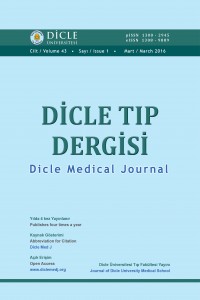Abstract
Objective: It is known that prokinetic agents increase the motility of stomach and intestine. Although there are many studies on the motility of colon, its mechanism is not well clarified. The aim of this study to investigate the effects of prokinetic agents on proximal and distal colon tissues.
Methods: Forty male wistar albino rats were allocated into five groups. Rats divided five group as a control, erythromycin, ampicillin, domperidon and metoclopramide. Before taking the tissue samples, this four agents were given by oral gavage, three times a day. The proximal and distal colon tissues were taken after the sacrification of rats, the colonic segments were mounted in 10 ml organ baths in the direction of circular muscles, and the contractions were recorded by a polygraph. The changes in the amplitude (% of KCl) and frequency (number/min) of contractions were analyzed before and after the addition of antagonists. The antagonist responses were taken by L-NNA, indomethacin, nimesulid, hexamethonium and tetradotoxin.
Results: While investigating the mechanism of the contraction changes, L-NNA, indomethacin, nimesulid significantly increased the amplitude of both proximal and distal colon spontaneous contractions compared with control group but hexamethonium and tetradotoxin did not. According to the frequency responses, the erythromycin group responses were significantly higher than control group.
Conclusions: Erythromycin, ampicillin, domperidon and metoclopramide may be useful to increase the motility of gastrointestinal system. On the other hand, the use of these agents in combination with nitric oxide synthase inhibitors and prostaglandin synthesis inhibitors may increase the effects of these agents.
Key words: Prokinetic agents, colon, motility, amplitude, frequency
References
- Curry JI, Lander TD, Strınger MD. Review article: Erythromycin
- as a prokinetic agent in infants and children. Aliment Pharmacol Ther 2001;15:595-603.
- Mt-Isa S, Tomlin S, Sutcliffe A, et al. Prokinetics prescribing in paediatrics: evidence on cisapride, domperidone, and metoclopramide.. J Pediatr Gastroenterol Nutr 2015;60:508-514.
- Acosta A, Camilleri M. Prokinetics in gastroparesis. Gastroenterol
- Clin North Am 2015;44:97-111.
- Gomez R, Fernandez S, Aspirot A, et al. Effect of amoxicillin/ clavulanate on gastrointestinal motility in children. J Pediatr Gastroenterol Nutr 2012;54:780-784
- Dinning PG, Carrington EV, Scott SM. Colonic and anorectal motility testing in the high-resolution era. Curr Opin Gastroenterol
- ;32:44-48.
- Başaklar AC. Bebek ve Çocukların Cerrahi ve Ürolojik Hastalıkları. Palme Yayıncılık, 2006, Cilt 1;605-611.
- Dong K, Li B, Guan QL, Huang T. Analysis of multiple factors of postsurgical gastroparesis syndrome after pancreaticoduodenectomy
- and cryotherapy for pancreatic cancer. World J Gastroenterol 2004;10:2434-2438 .
- Loening-Baucke V. Functional fecal retention in childhood. Practical Gastroenterology 2002;26:13-25.
- Southwell BR, King SK, Hutson JM. Chronic constipation in children: organic disorders are a major cause. J Paediatr Child Health 2005;41:1-15.
- Banner SE, Smith MI, Bywater D, et al. Increased defecation caused by 5-HT4 receptor activation in the mouse. Eur J Pharmacol 1996;308:181-186.
Abstract
References
- Curry JI, Lander TD, Strınger MD. Review article: Erythromycin
- as a prokinetic agent in infants and children. Aliment Pharmacol Ther 2001;15:595-603.
- Mt-Isa S, Tomlin S, Sutcliffe A, et al. Prokinetics prescribing in paediatrics: evidence on cisapride, domperidone, and metoclopramide.. J Pediatr Gastroenterol Nutr 2015;60:508-514.
- Acosta A, Camilleri M. Prokinetics in gastroparesis. Gastroenterol
- Clin North Am 2015;44:97-111.
- Gomez R, Fernandez S, Aspirot A, et al. Effect of amoxicillin/ clavulanate on gastrointestinal motility in children. J Pediatr Gastroenterol Nutr 2012;54:780-784
- Dinning PG, Carrington EV, Scott SM. Colonic and anorectal motility testing in the high-resolution era. Curr Opin Gastroenterol
- ;32:44-48.
- Başaklar AC. Bebek ve Çocukların Cerrahi ve Ürolojik Hastalıkları. Palme Yayıncılık, 2006, Cilt 1;605-611.
- Dong K, Li B, Guan QL, Huang T. Analysis of multiple factors of postsurgical gastroparesis syndrome after pancreaticoduodenectomy
- and cryotherapy for pancreatic cancer. World J Gastroenterol 2004;10:2434-2438 .
- Loening-Baucke V. Functional fecal retention in childhood. Practical Gastroenterology 2002;26:13-25.
- Southwell BR, King SK, Hutson JM. Chronic constipation in children: organic disorders are a major cause. J Paediatr Child Health 2005;41:1-15.
- Banner SE, Smith MI, Bywater D, et al. Increased defecation caused by 5-HT4 receptor activation in the mouse. Eur J Pharmacol 1996;308:181-186.
Details
| Primary Language | Turkish |
|---|---|
| Journal Section | Research Articles |
| Authors | |
| Publication Date | March 1, 2016 |
| Submission Date | March 29, 2016 |
| Published in Issue | Year 2016 Volume: 43 Issue: 1 |


